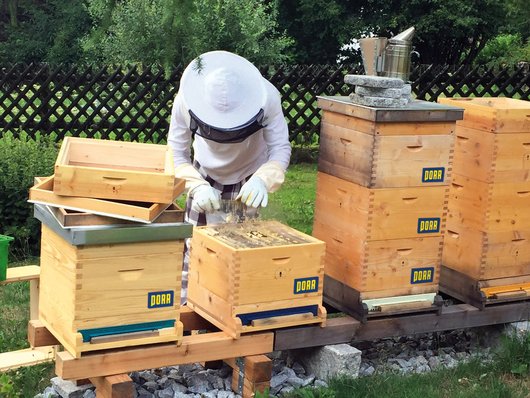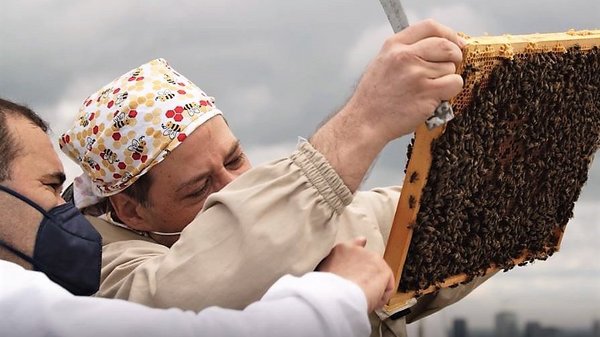![[Translate to Englisch:] (c) UBM Development [Translate to Englisch:] (c) UBM Development](/fileadmin/_processed_/3/9/csm_20190325btpa_mgr_th62_k06_day_prefinal01-2-scaled_864227496b.jpg)
bee@PORR: of the birds and the bees
There are more than 16,000 types of bee in the world. The honeybee is their star player. Not only because it is the best-known species. It also happens to pollinate around 80% of all crops and wild plants. If it were to die out, then people would have to do this job instead, pollinating each plant by hand. There are some gardens in Japan where this is already the sad reality.
Endangered
Bees are primarily threatened by environmental influences, pesticides and parasites such as the Varooa mite. That said, sometimes they also lack habitat or food. There are some species that only fly to certain types of plant. If the plant disappears, the bee species dies out. In contrast, the honeybee requires a balanced diet that cannot be provided by artificial monocultures or freshly mown lawns.
We have already installed 435 hives, with more than 20 million bees living there in summer.
Holistic
Bee aware and care. That’s the motto of the initiative bee@PORR, under which we are taking key steps to prevent bee deaths. We have given bee populations a home at 40 international locations. Since 2017 we have already installed 435 hives, with more than 20 million bees living there in summer. We work with professional and amateur beekeepers and provide them with beehives and colonies as needed. This is sustainable, but still not enough. We have adopted a holistic approach. That’s why we prefer to use hives made of untreated timber.
Busy
Our bees produce up to eight tonnes of honey every year. It goes without saying that our beekeepers get to keep the majority. But we bottle around a quarter of the total to hand out on special occasions. The small PORRtion of honey is not only well-loved and sought-after, it is also a sweet message that raises awareness, making the recipient think of bees and the important part they play. And that can be decisive. After all, it is only by standing together that we can make an impact and protect the endangered bee.
Extraordinary
By the way, bees are quite capable of handling zero gravity. We know this because there were 3,400 bees on board the Challenger space shuttle sent to space in April 1984. For more fascinating facts, interesting info and top tips, take a look at our info box.
5 fascinating facts about bees
Did you know …
- … that bees have five eyes? Two large compound eyes and three smaller ocelli eyes. They allow them to perceive up to 300 images per second. We humans manage a mere 25 to 60. What’s more, bees can see UV light although not the colour red.
- … that most bees live alone? Only five percent of bee species live in a community with a queen and around 50,000 to 60,000 worker bees in summer plus 1,000 drones or male bees. The best-known species in the world is the Carniolan honeybee, native to Carniola, Slovenia.
- … that bees fly to more than 2,000 flowers? Per day. The greater the diversity of species, the better.
- … that bees can be taught to detect explosives? In the US city of Los Alamos, bees are in training to identify explosives, with the Pentagon financing the project.
- …. that the bee is the third most useful animal thanks to the immense work it does in pollination? Number one? The cow. Number two? The pig. The chicken has had to relinquish third place to the bee.
3 top tips from our pros
- Bees like wildflowers. Whether in the garden, on the terrace or on the balcony. They love choosing from an abundant range of flowers. The important thing is for the plants not to have been treated with pesticides.
- in summer, the following plants are ideal: dandelion, raspberry, marsh marigold, daisy, fennel, sage, leucanthemum, peppermint, sunflower, lily, thyme, oregano, dill, lavender, camomile, ivy, geranium, petunia, fuchsia.
- Bees like it if you don’t mow your lawn immediately but let some weeds and plants, like dandelions, grow instead.


Related links
- Visit our YouTube channel and form your own impression of bee@PORR.
- On our website you can find detailed info on bee@PORR and our other measures to encourage sustainability.


![[Translate to Englisch:] Linus Lintner Fotografie Am Mauerpark, ein Objekt der Porr Deutschland GmbH](/fileadmin/_processed_/8/1/csm_20180614_Zalando__1__35ef3e9bd7.jpg)
